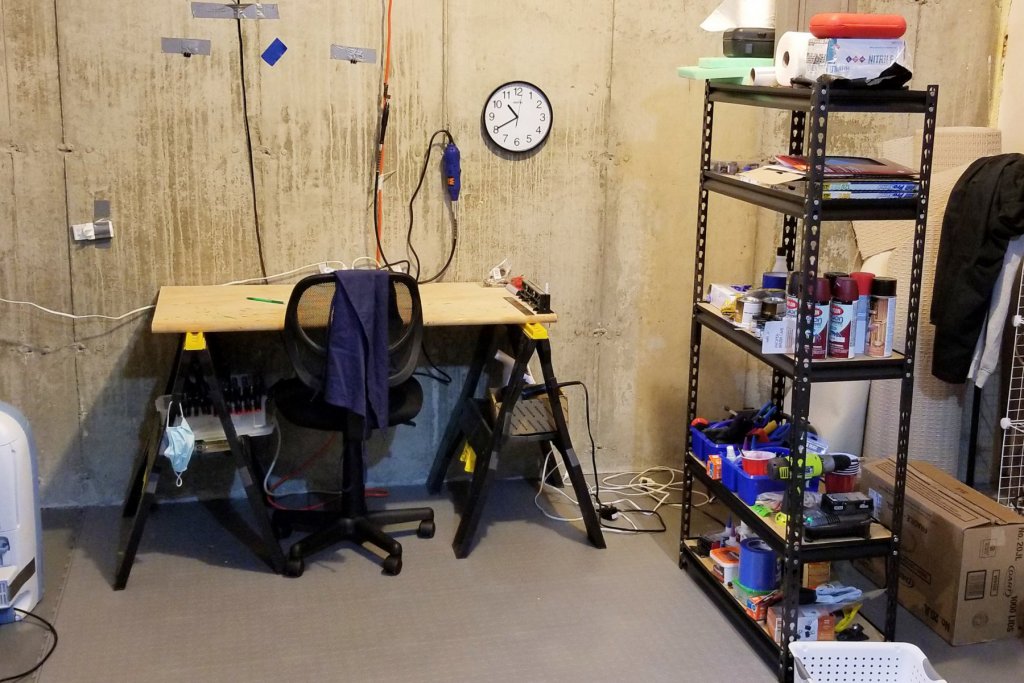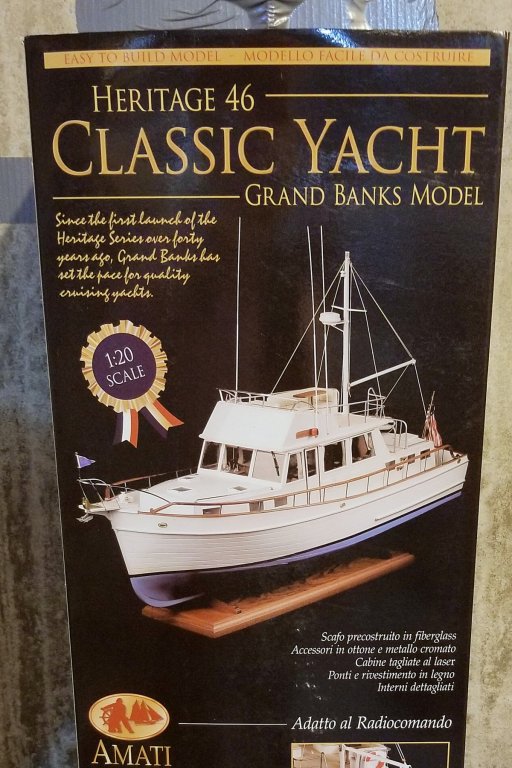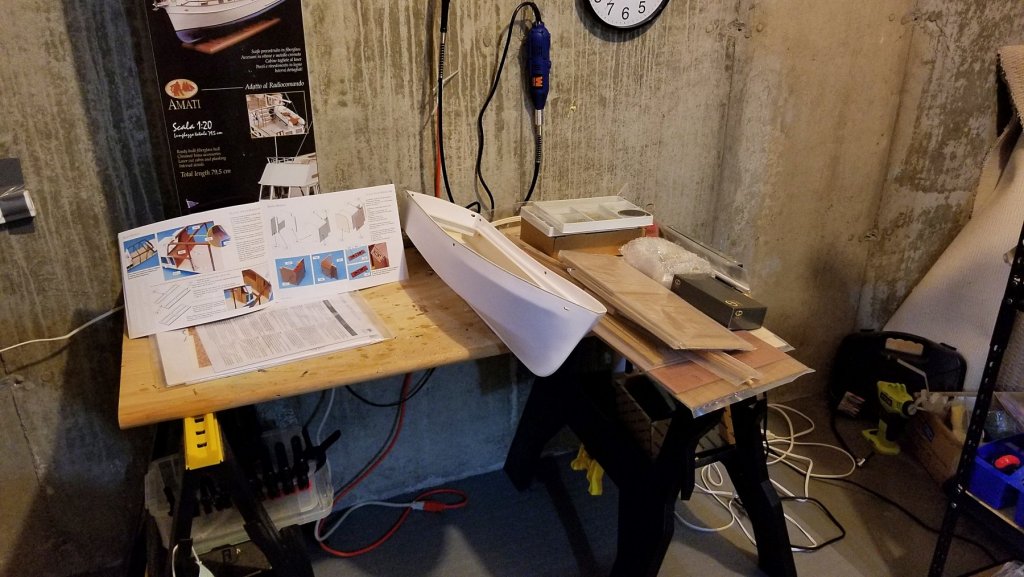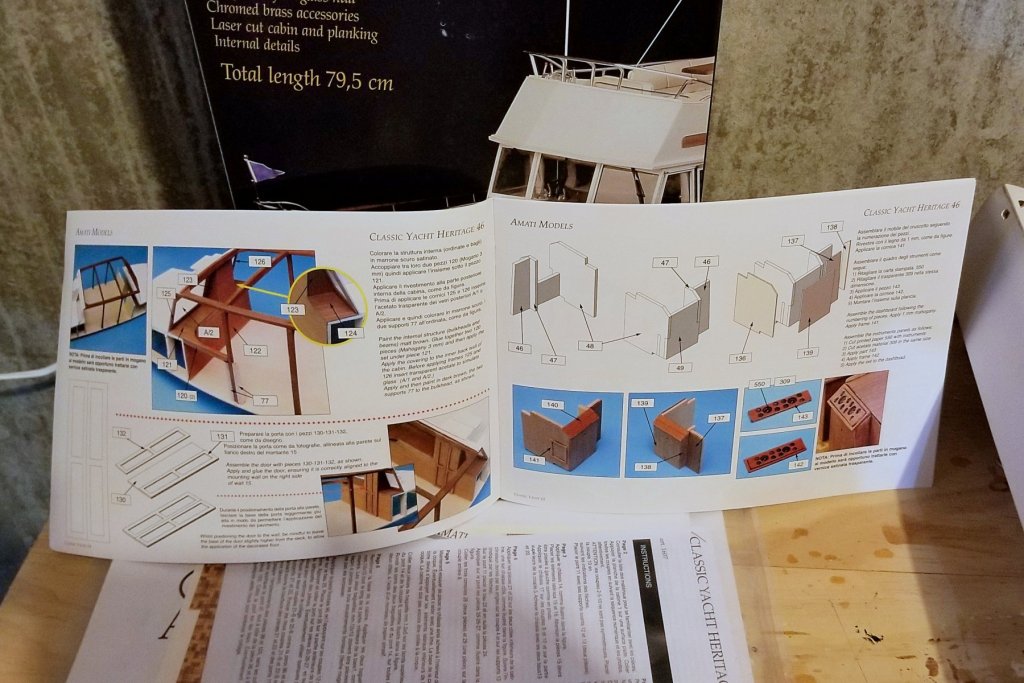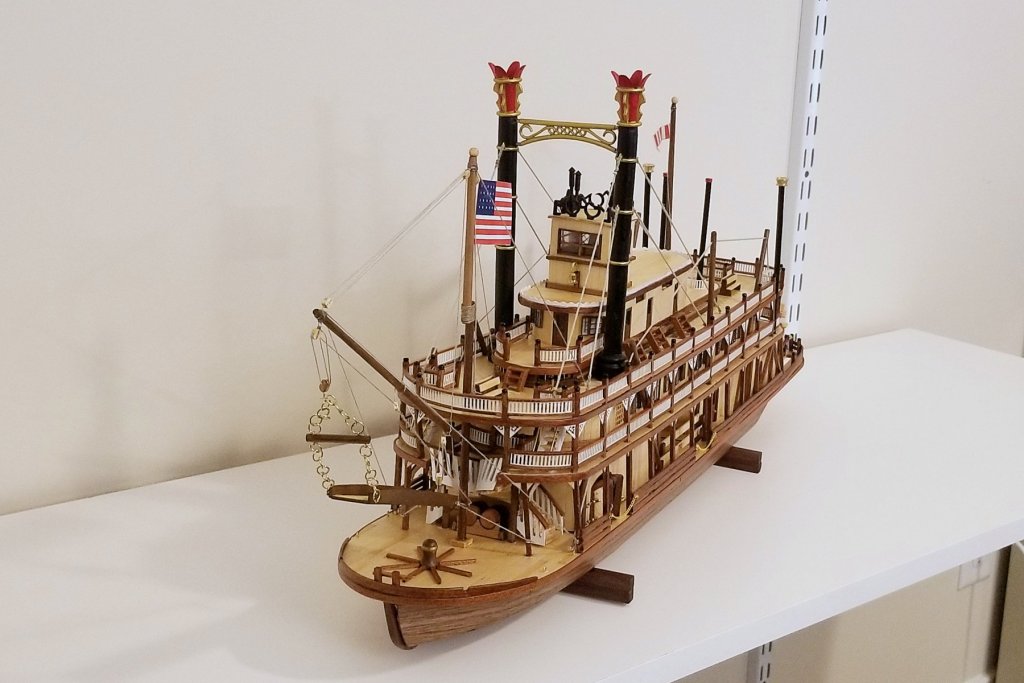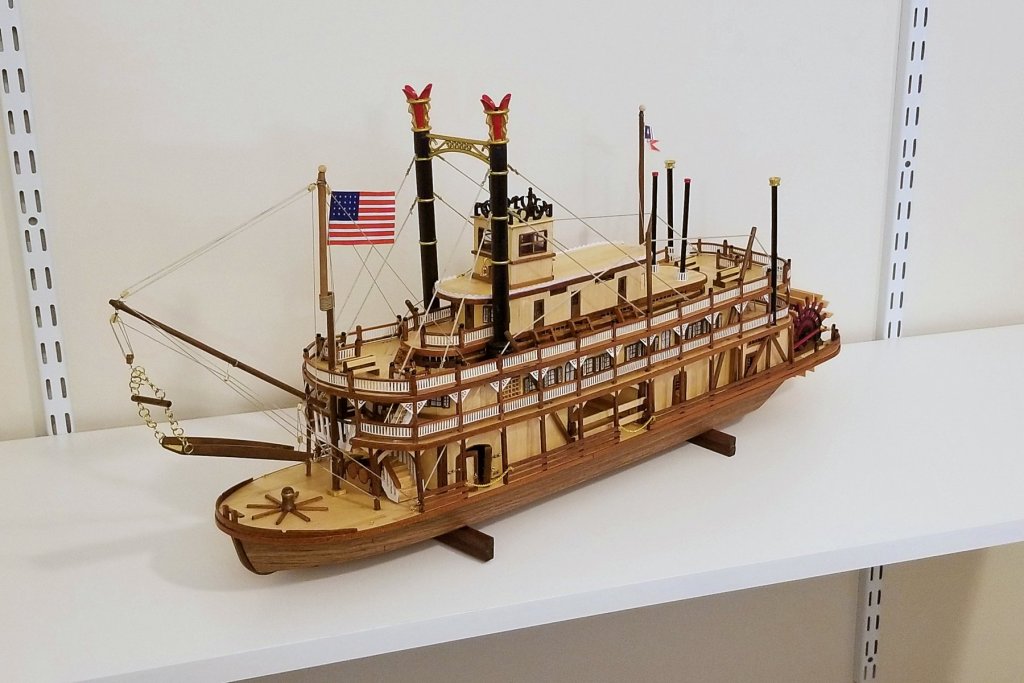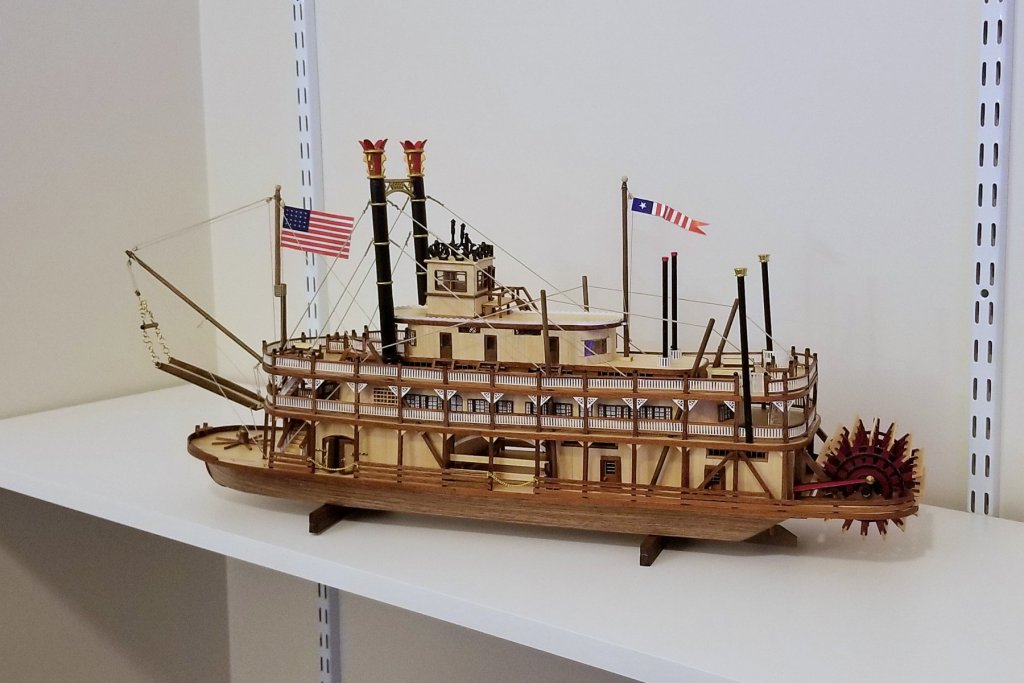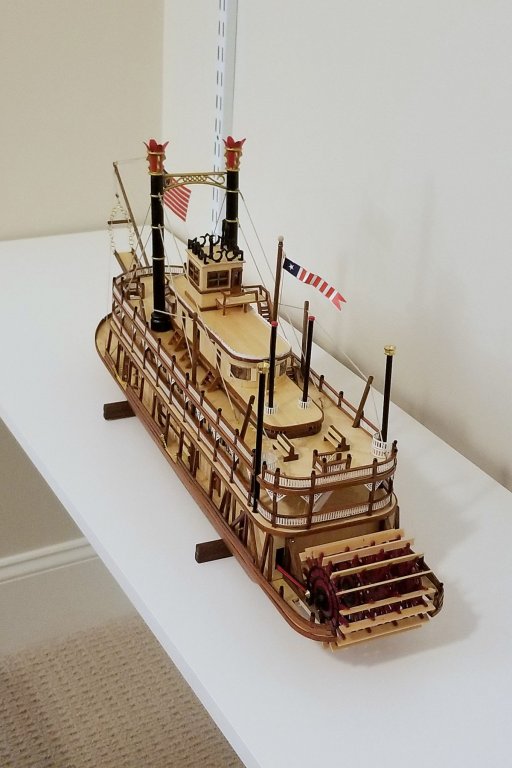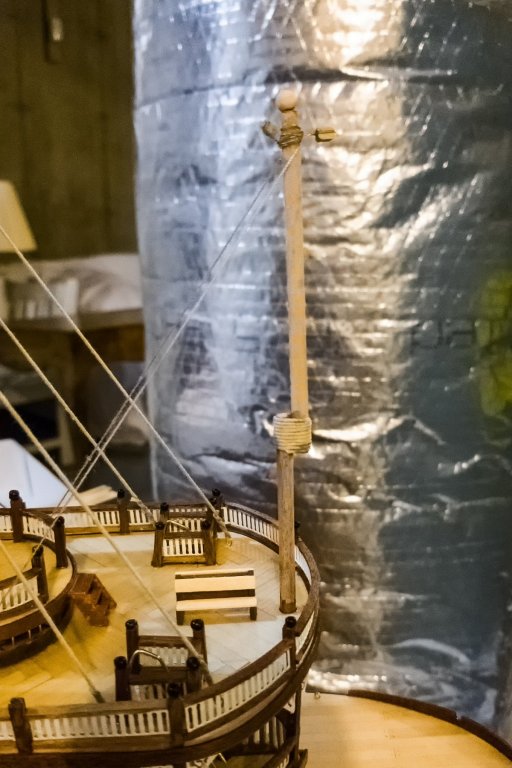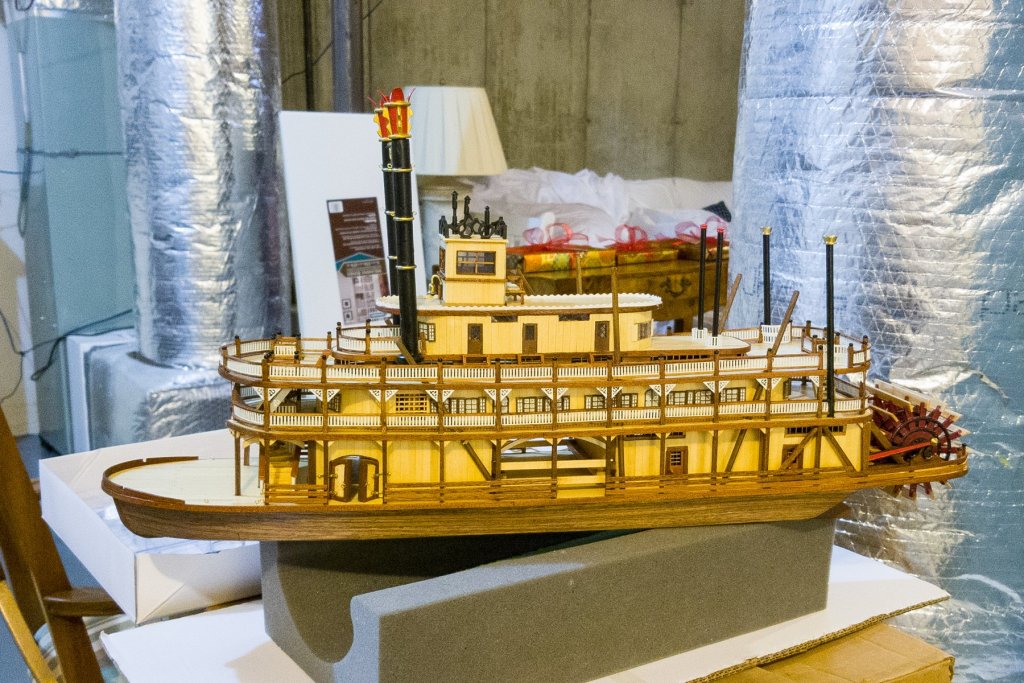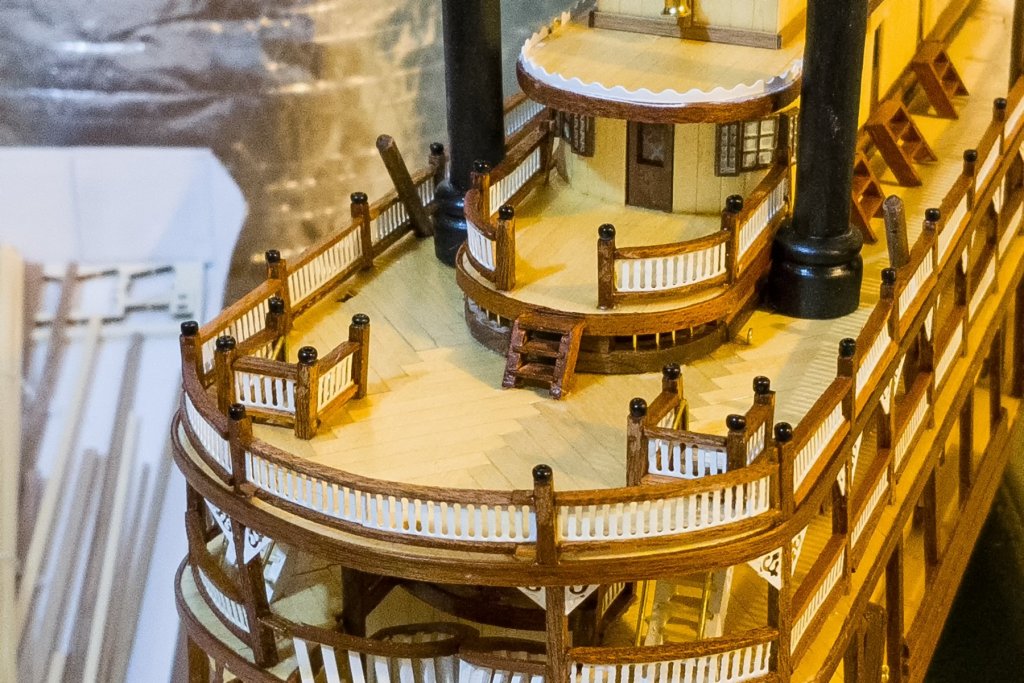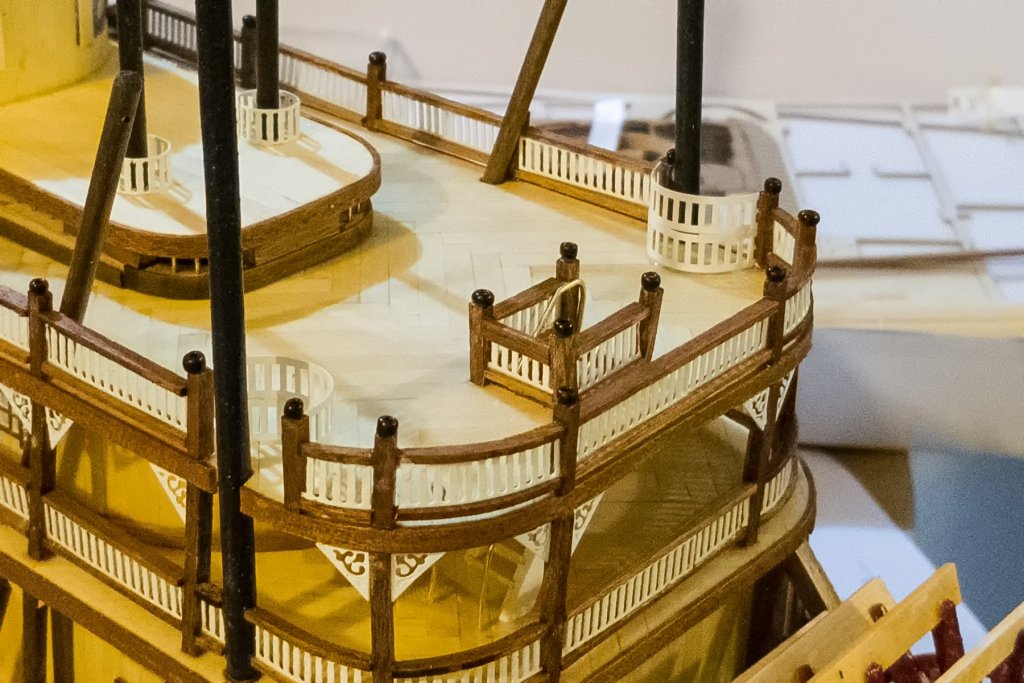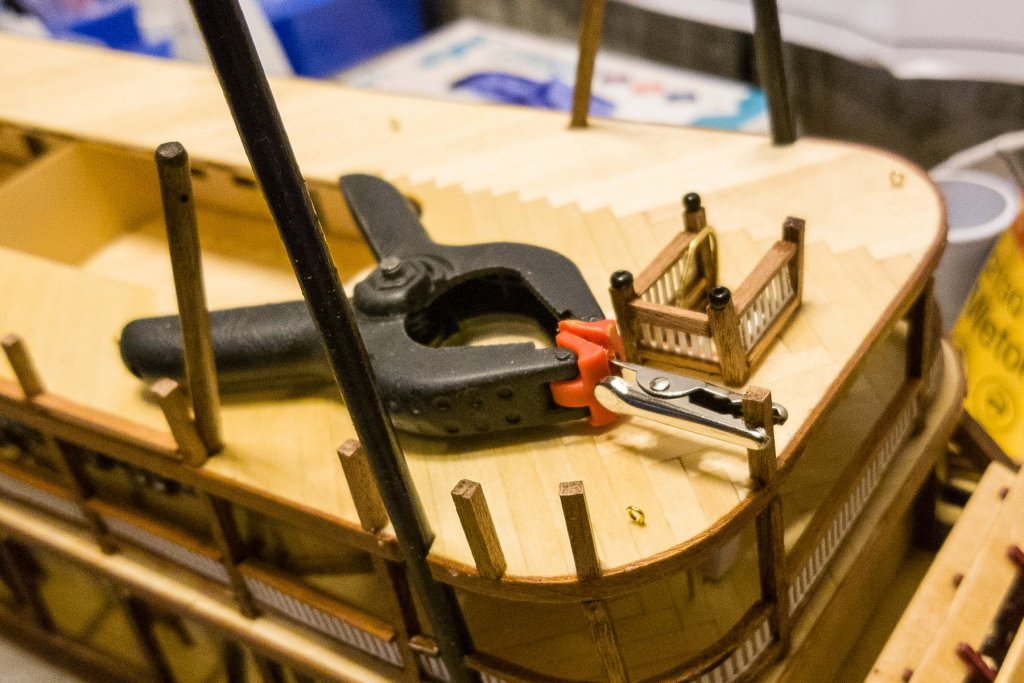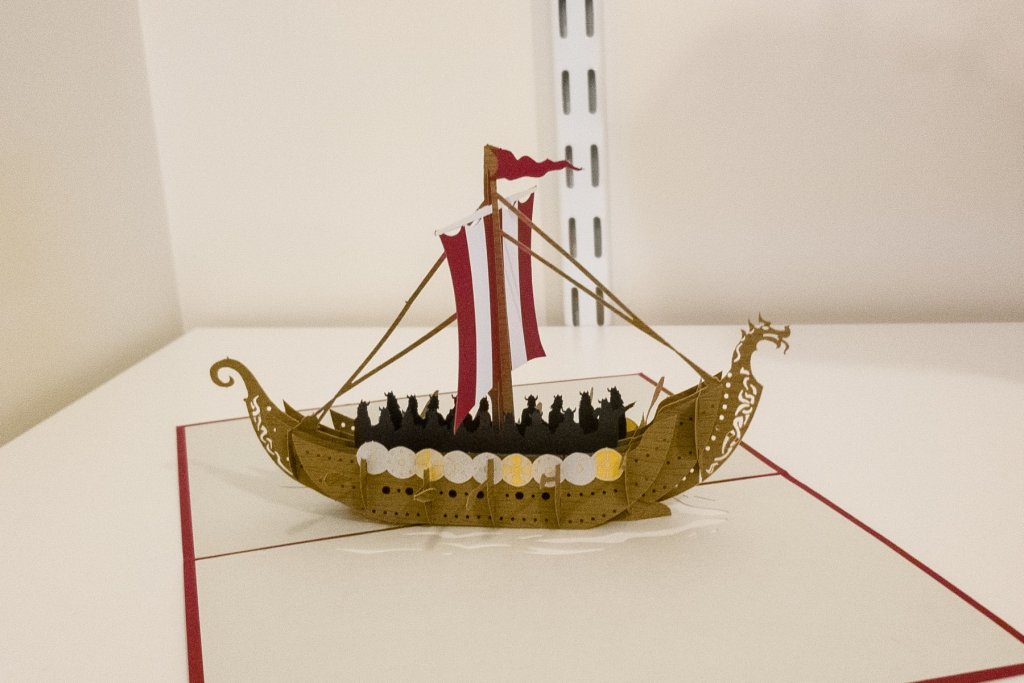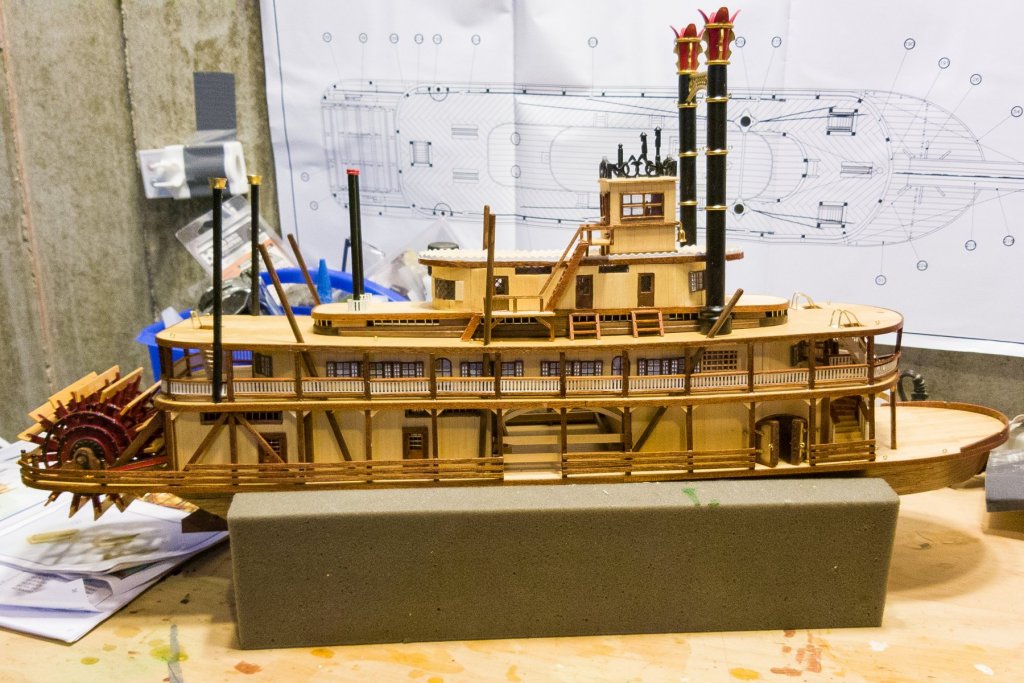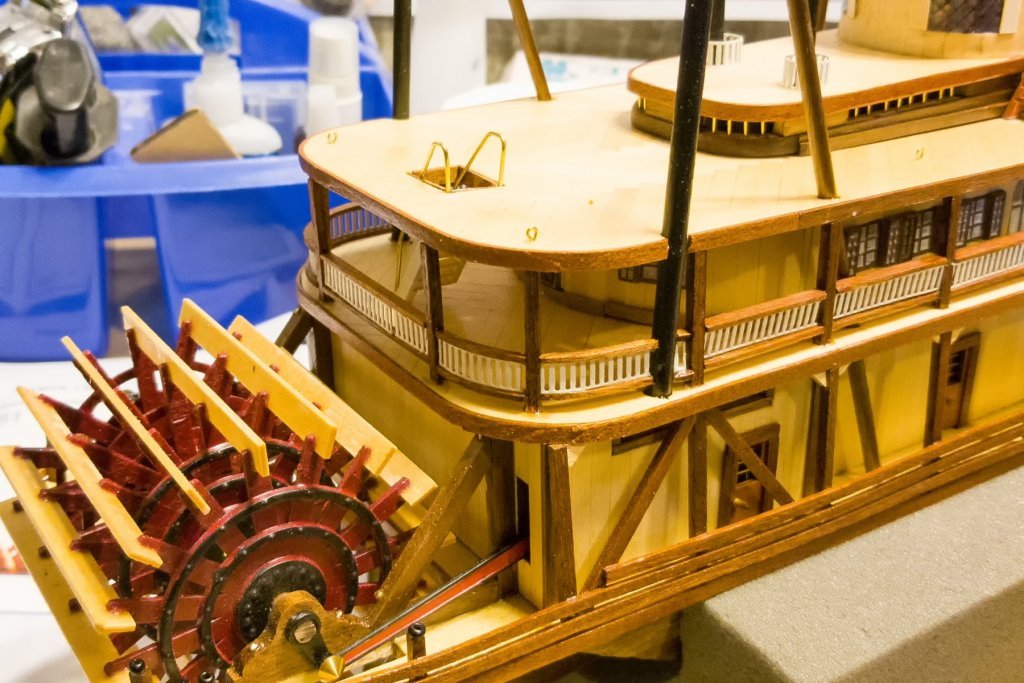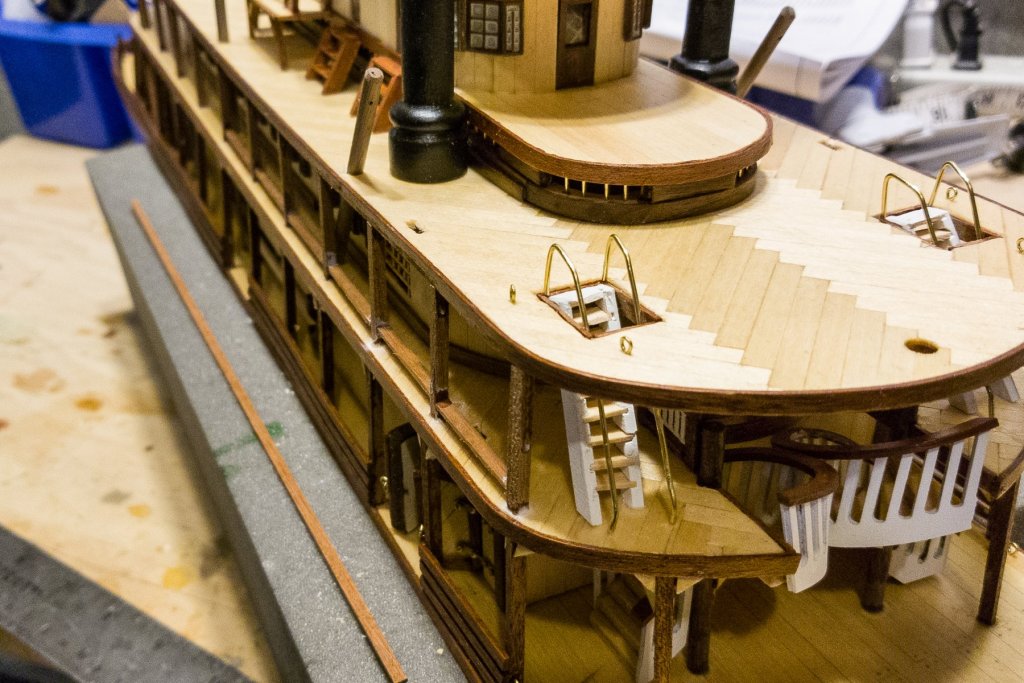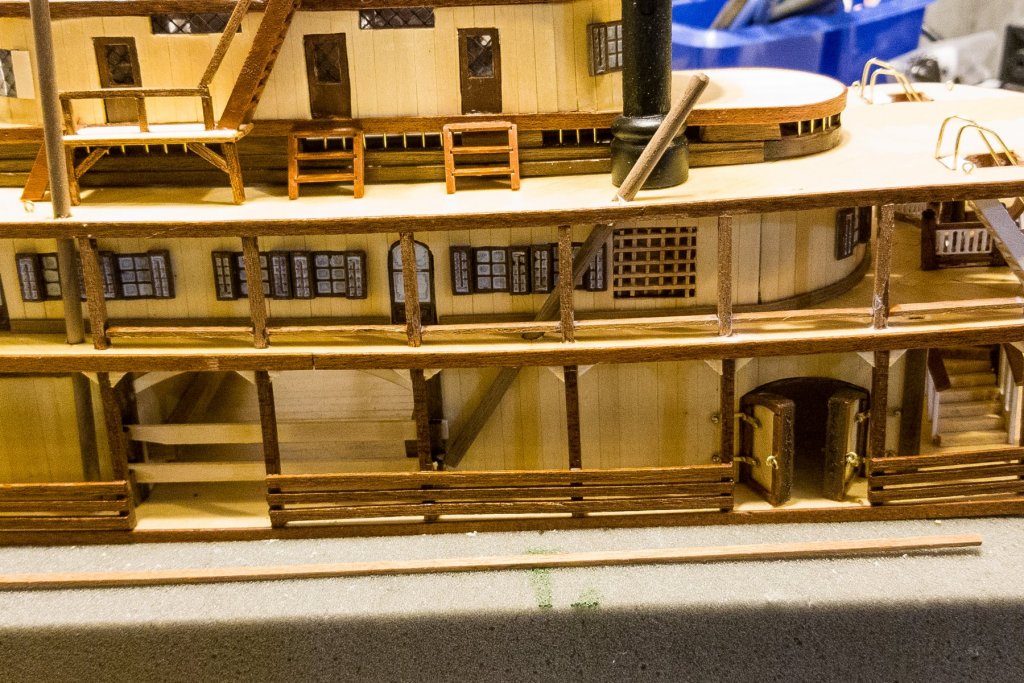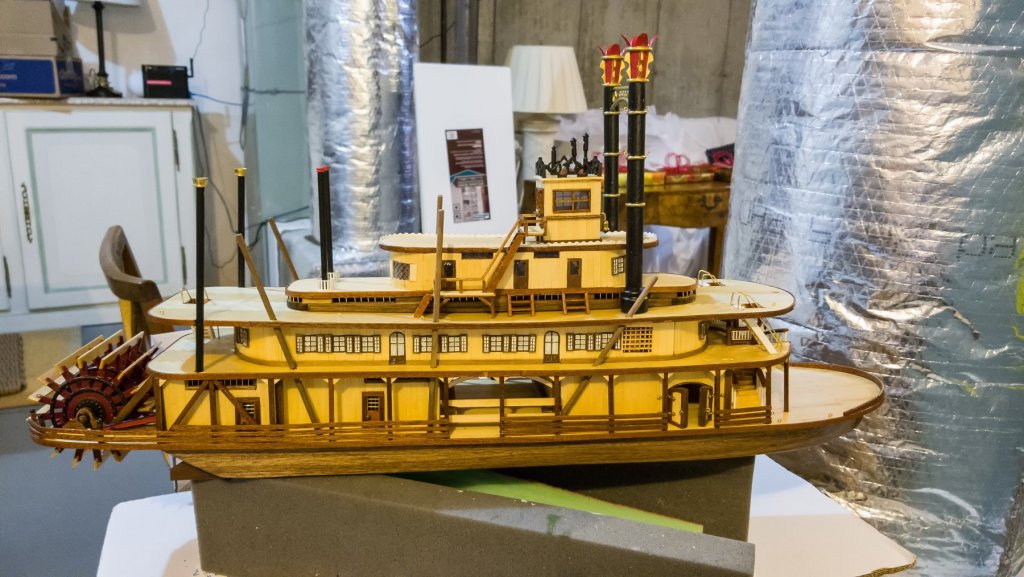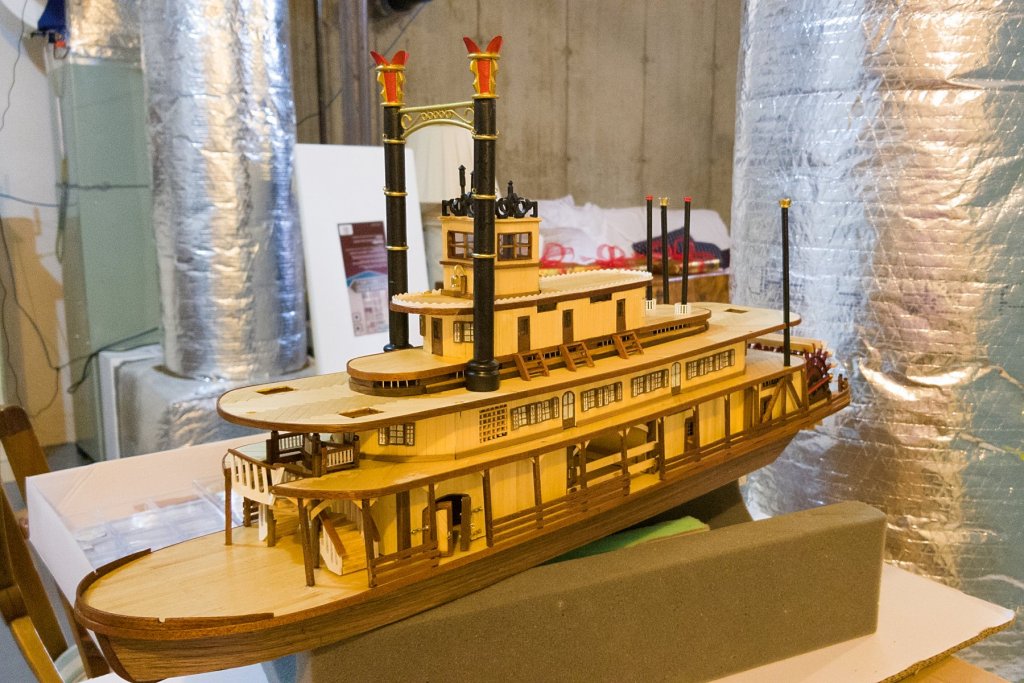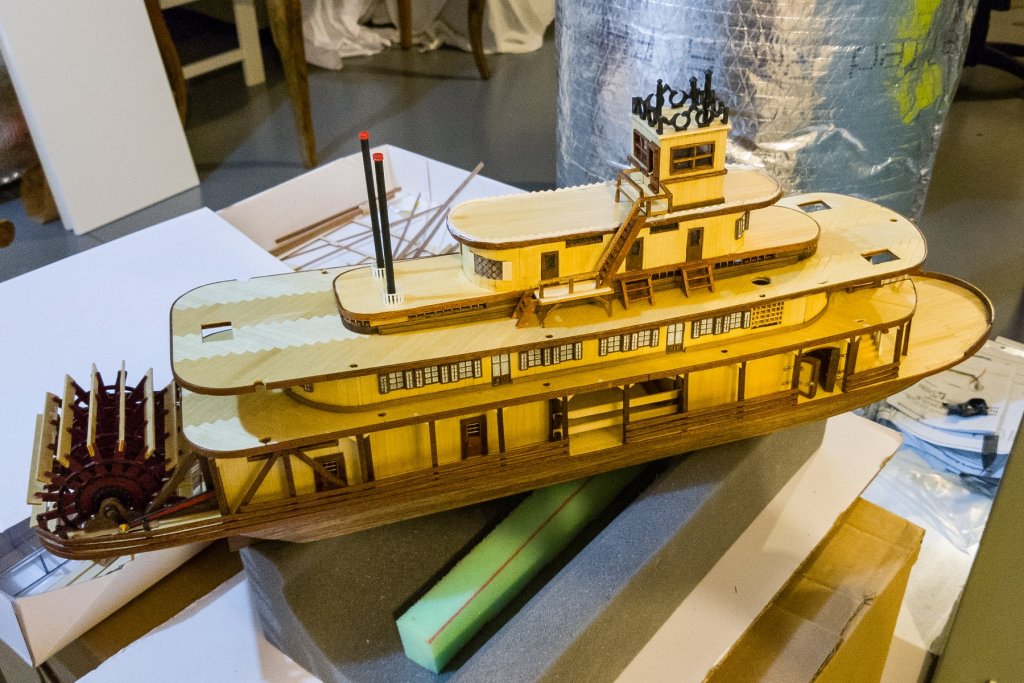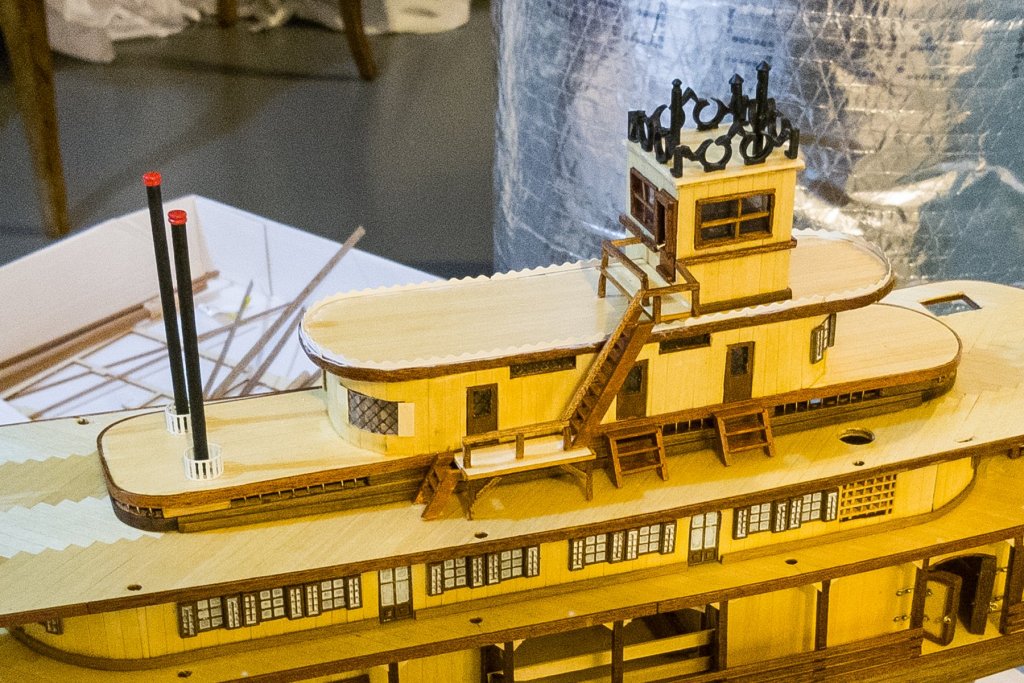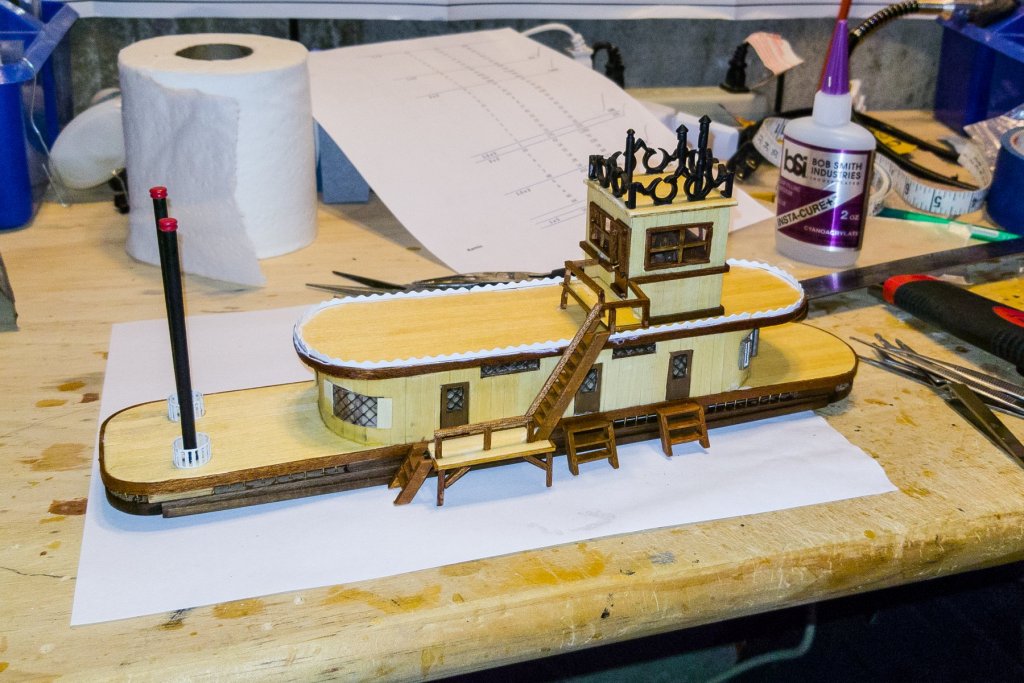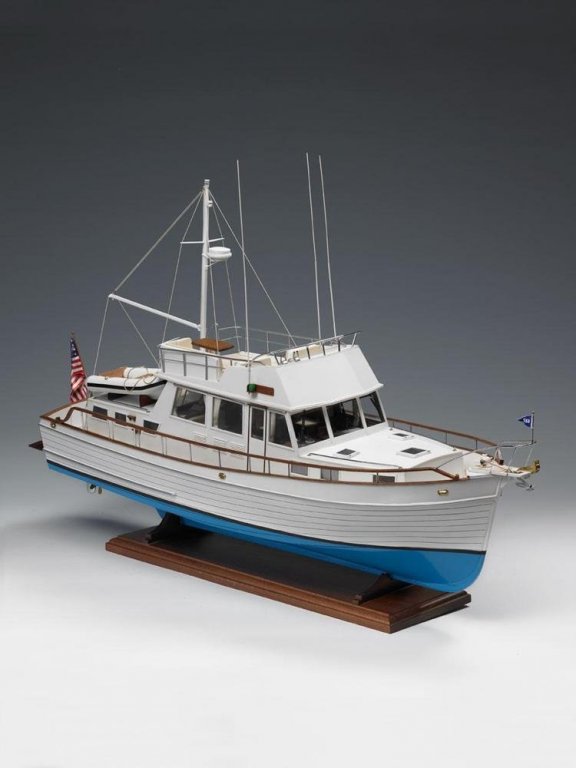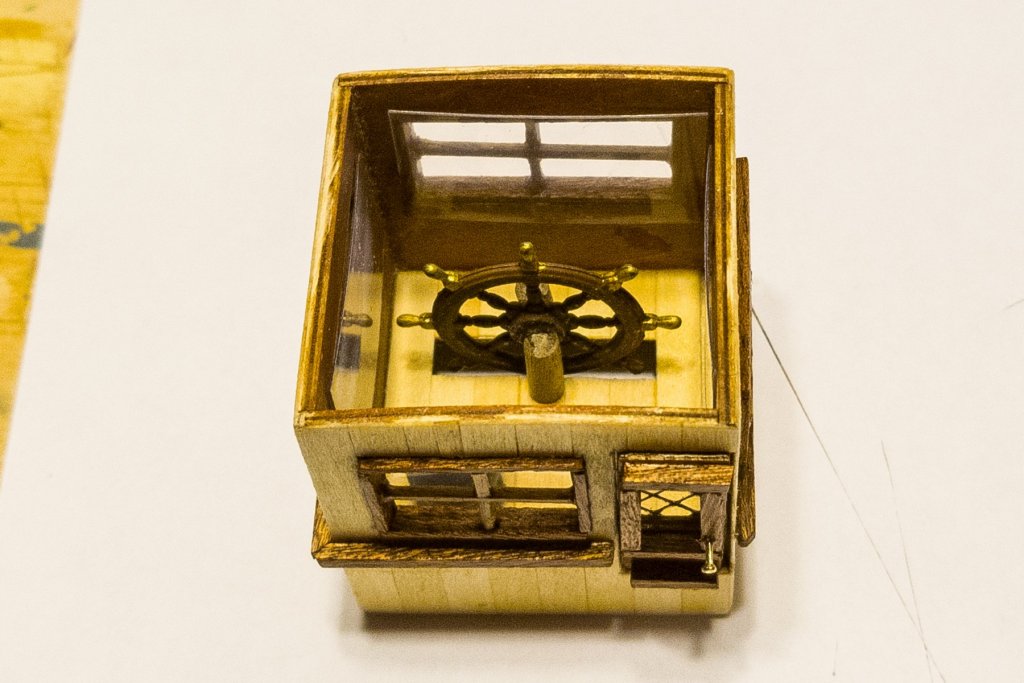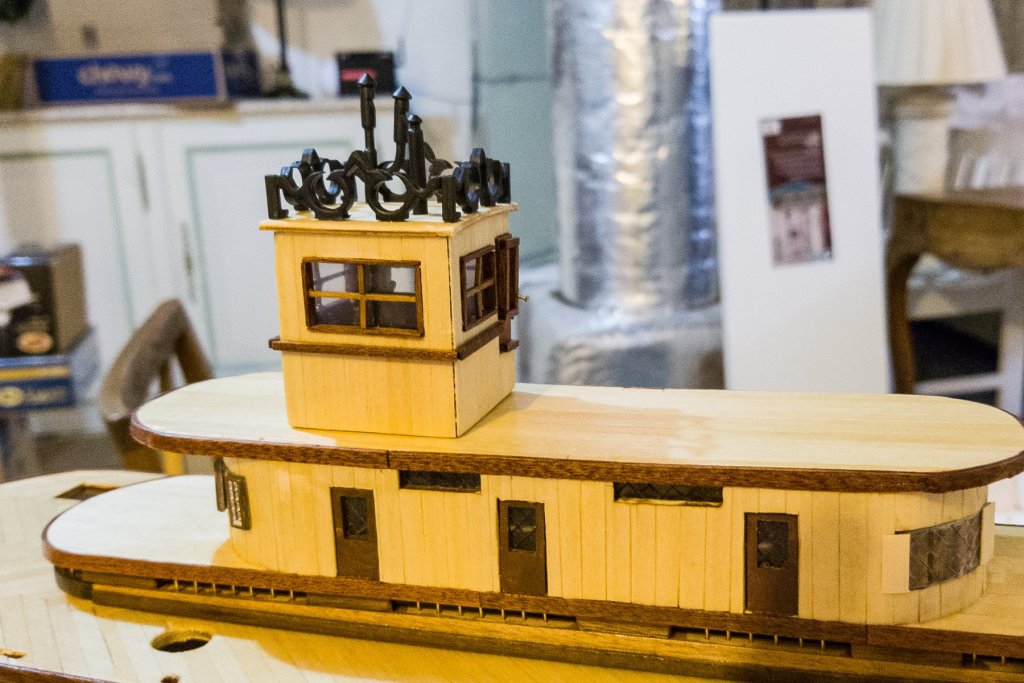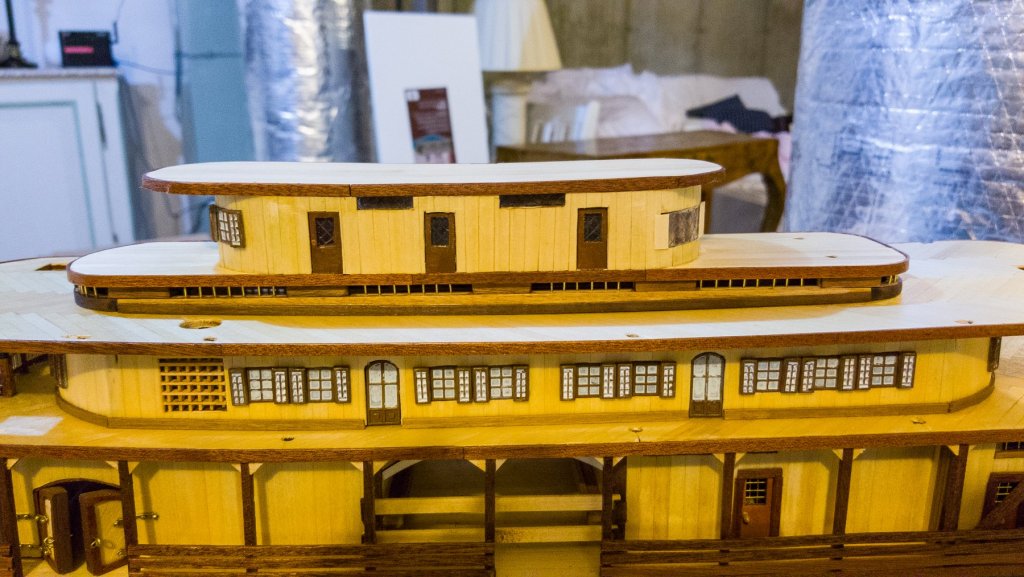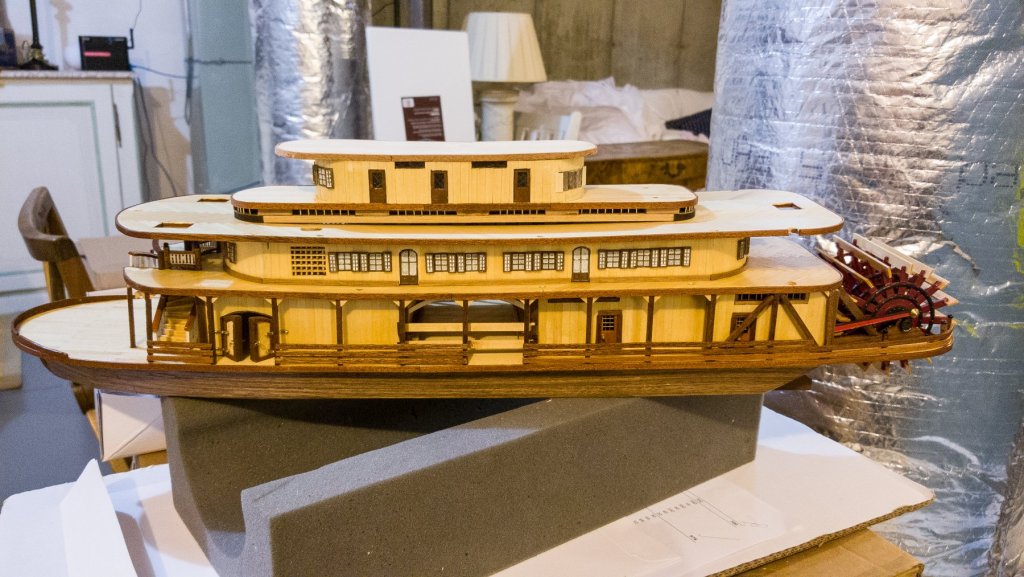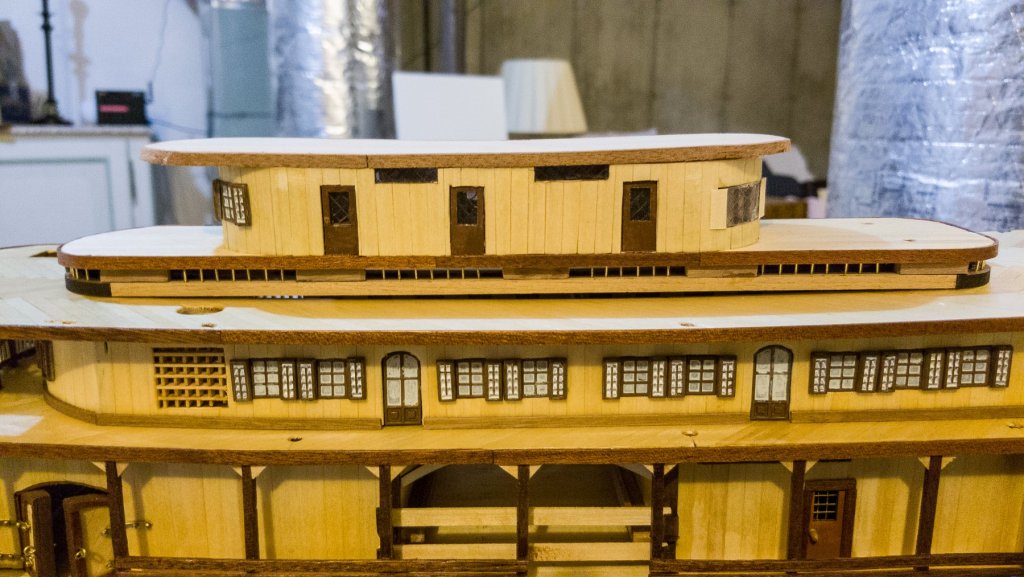-
Posts
1,071 -
Joined
-
Last visited
Content Type
Profiles
Forums
Gallery
Events
Everything posted by drobinson02199
-
Before getting to the model itself, I revamped my model building space. The rolling chair was gouging a hole in the concrete floor, and all of my supplies were in boxes and bags scattered on the floor around my work table. So I found some industrial plastic tiles on the internet (they just interlock and lay down -- no adhesion so easy to remove). The nice thing about them is that I can replace individual tiles if the chair eventually chews some of these up, or they get too groady. Then steel shelving to hold all the "stuff". See attached picture. Now I'm ready for this model. This is the Amati Grand Banks, and I'm not sure if there has been a build log done on this one before. See picture of the box cover. I picked this one to create some variety from the historical ships, some relief from rigging after the Revenge, and finally because it's Amati. I'm getting the sense that their kits stand a head above others, at least the manufacturers I have tried (AL, Bluejacket, Constructo, Dumas). There's a "what's in the box" picture, and the usual laser cut sheets, wood, and boxed parts are there. But this one has a pre-formed fiberglass hull, because it can be built for R/C operation. I'm not going to do that. The hull is REALLY thick and solid (compared to the Dumas Mt. Washington, which was a thinner plastic and also R/C adaptable). Finally, there is a very well-illustrated manual. See pic. Plus a number of charts to go up on the wall. So I'm looking forward to this one, and because it's not the usual double-plank construction, I'm expecting some new twists. Regards, David
-
Thanks, Chris. I have some floating shelves that I use for models this size, and I'll put a new one up in my office for this model. It will be on the same wall as three others I have built that are about this size. Regards, David
- 104 replies
-
- king of the mississippi
- artesania latina
-
(and 1 more)
Tagged with:
-
FINISHED!! My build of King of the Mississippi is now complete. Pictures attached. Need to create a shelf for this in my office, and do a cleanup on the workroom. Might start the next one (Amati Grand Banks) before I go away on the 6th for a week in the Carib. Regards, David
- 104 replies
-
- king of the mississippi
- artesania latina
-
(and 1 more)
Tagged with:
-
Another adaptation: one issue with this kit is the lack of any spares, and in some cases (eyebolts), some serious parts shortages. And in many cases, you get just enough wood, and you have to be careful to use it up efficiently. When it came time to make the forward mast, I found that I had just enough of the right diameter wood -- but in two pieces! Earlier cuts of that diameter had left me with two shorter pieces in place of one just barely long enough. My choices were to either use a smaller diameter, or do what I ended up doing -- which is to create a two-part mast. Looks kind of interesting. The mast in the picture isn't varnished yet. Regards, David
- 104 replies
-
- king of the mississippi
- artesania latina
-
(and 1 more)
Tagged with:
-
Scott: She is gorgeous! I'm in awe of your craftsmanship, and the model is spectacular. Regards, David
-
Antony: If you look at the third picture above your post, you'll see a semicircular guard on the inside of the third deck, which I assume was to keep passengers from getting close to the pipe. That replaces the handrail at that point. However, down on the second deck there IS a handrail and no internal guard, even though there would have been passengers and crew there who could get too close to the pipe. I built it the way the model pictures and drawings show, but I suspect it's historically inaccurate on the second deck. Regards, David
- 104 replies
-
- king of the mississippi
- artesania latina
-
(and 1 more)
Tagged with:
-
Now all the railings are up, so I guess I really am getting close to the end. What remains is the masts, some light rigging, and the deck ornamentation. I particularly like the look of the bow and stern curved railings. Regards, David
- 104 replies
-
- king of the mississippi
- artesania latina
-
(and 1 more)
Tagged with:
-
Chris: It's a website called Love Pops: https://www.lovepopcards.com/ They actually have a bunch of ships. Regards, David
- 104 replies
-
- king of the mississippi
- artesania latina
-
(and 1 more)
Tagged with:
-
Back to the boat. I fabricated a jig to hold the third deck posts upright and in position while the glue dries. Because there's no mechanical hold on these pieces, it's taking a long time to get them all up. But the jig works and keeps them properly aligned. Regards, David
- 104 replies
-
- king of the mississippi
- artesania latina
-
(and 1 more)
Tagged with:
-
A diversion -- in honor of my new hobby, my wife gave me this detailed pop-up card for my birthday. Regards, David
- 104 replies
-
- king of the mississippi
- artesania latina
-
(and 1 more)
Tagged with:
-
Scott: I just caught up to your build log on this model. Wow! Now I see what it looks like when someone who really knows what he's doing (and has more patience and steadier hands than me) builds one. This is a spectacular piece of craftsmanship. Regards, David
-
I have finished the second deck railings, and here are a couple of pics. I like the way the railing curves around at the stern. I am now more amused by the last paragraph of the manual when it said "most of the detail work is now done; just follow the pictures from here on" and then ended. In terms of detail work: every vertical post and horizontal wood railing (both under and over the white part) had to be individually hand-fitted, with lots of careful sanding to get the lengths right, as they aren't quite uniform. Same true of the white parts of the railings. So if that isn't detail work, I'm not sure what is. I will now do the railings around the stair openings on deck 3 first, because I'll have a clear shot at them before I put up the posts and railings on Deck 3. Regards, David
- 104 replies
-
- king of the mississippi
- artesania latina
-
(and 1 more)
Tagged with:
-
A construction discovery -- the third deck is not quite as wide as the second. It's 3mm narrower on both sides. That left me with two choices: If I wanted the vertical second deck posts to be flush with the edge of both deck 2 and deck 3 (as shown in the photographs in the manual), then I'd have to noticeably cant the posts inward from bottom to top. Or, I could align the posts to the edge of deck 3 and move them in on deck 2 about 3mm. I picked the second option, as I thought the canted posts would look awful, and I don't think the "indentation" of the posts looks bad. I installed some of the lower railings, and you can see how it looks in the pics here. Regards, David
- 104 replies
-
- king of the mississippi
- artesania latina
-
(and 1 more)
Tagged with:
-
Not a lot of visually interesting stuff in this post, but some useful construction tips from my experience. I looked over the plans to see what I should install before doing the railings, so I wouldn't have access issues. That turned out to be the stairs and railings fore (2) and aft (1), the three masts on either side, and most of the eyebolts. Some learnings: Once the ladder rails are painted, the paint adds width which makes them too wide for the deck openings. So I reduced the tread length from 10mm to 9mm and clamped them to be sure they were seated. It was helpful to shape one brass stair railing and then use it as a template for the others before installing any. The two slanted masts on each side require some work on the deck holes they fit into -- but the second deck holes aren't drill-accessible. I didn't have long bits, so I opened out the third deck hole on a slant, then inserted the bit and manually turned it through the second deck hole on a slant using a wrench. It worked, and wasn't much trouble, but doing the ship again I'd want to make those second deck slanted drills before installing the third deck. Now I can move on to the railings without having to maneuver around them later on. That would have been really hard if I'd tried to open those mast holes after the railings were on. Regards, David
- 104 replies
-
- king of the mississippi
- artesania latina
-
(and 1 more)
Tagged with:
-
Chris: The stacks are wood dowels. Needed some sanding to fit the rings and stack bases over, then one coat of Model Master flat black, and one coat of satin polyurethane varnish. The large stack tops are cast metal, hand-painted. The rear stack tops are solid brass pieces. As I noted earlier, I had to hijack and re-purpose two deadeyes for the small red stack tops. I really like Model Master acrylic paint since I began using it. Covers really well, but cleans up with water. Regards, David
- 104 replies
-
- king of the mississippi
- artesania latina
-
(and 1 more)
Tagged with:
-
Antony: Yes, I keep all my boats, and I'm eventually going to run out of wall space in my office! What's the alternative? What else do you do with yours besides display them? Regards, David
- 104 replies
-
- king of the mississippi
- artesania latina
-
(and 1 more)
Tagged with:
-
All the stacks are up now -- and I couldn't resist a picture because the color scheme on the tops of the main stacks is pretty cool. This is the scheme called for in the model. Regards, David
- 104 replies
-
- king of the mississippi
- artesania latina
-
(and 1 more)
Tagged with:
-
Chris: The deck colors are just a photo trick -- it's all the same stock planking from the kit. It's the ONLY thing AL provided spare amounts of -- everything else is either just enough, or short. No room for error. Regards, David
- 104 replies
-
- king of the mississippi
- artesania latina
-
(and 1 more)
Tagged with:
-
Antony: I just looked up your Turtle Ship, and your workmanship is incredible. Makes me realize how far I have to go in my own skills -- if I ever get there. Your last post was months ago. Are you still working on it? Regards, David
- 104 replies
-
- king of the mississippi
- artesania latina
-
(and 1 more)
Tagged with:
-
I've completed the top structure now, which has an interesting stair structure up to the wheelhouse. I kept it removable for now, not because I want to leave it that way on the finished model, but because I think the railings and other finish work on the deck it sits on will be easier to do if it's out of the way. See pictures. There were a number of construction issues here: The manual shows the ladders with white rails and natural steps, and I thought it was just the outside, so I assembled the ladder and then noticed that the entire rail needed to be painted white before assembly. So I decided to make the steps on this level brown, and go to the other color scheme on the lower decks. The ladders are constructed out of pre-cut rails, and pieces of step material that you have to cut to length. Turns out there aren't enough of those for all of the ladders on the boat (I looked ahead). So I went to my "leftover stuff" box (thank you Amati for extra material) and used ladders from that for the short ones. You'll notice that they are wider than the ladder in the structure. I have enough AL ladder material for the three on the lower decks, which is good because the Amati ladders would be too wide. The kit is also missing the top of the stacks you see. So back to the "leftover stuff" box and two small round deadeyes, wood filler in the holes, and they look pretty good. I decided to paint the tops red just to add some color to the model, and it matches red that will be on the tops of the main stacks later. The manual doesn't have the two platform edges finished, but I added some "leftover stuff" strips to finish it, since the rest of the structure has a lot of trim and finish. I also added a skirting board around the bottom of the wheelhouse to finish it off. [See Chris, I listen ] Speaking of construction, the instructions stop here, saying "most of the tedious and detailed work is now done -- follow the pictures for the rest." Since each vertical post has to be hand-sanded to fit, and there are a lot of railings to fit, I don't think the detailed work is quite done yet. Regards, David
- 104 replies
-
- king of the mississippi
- artesania latina
-
(and 1 more)
Tagged with:
-
Chris: Grand Banks is a modern power boat by Amati. I have attached their stock picture. After rigging the Revenge, I wanted to work on a couple of boats with no rigging. Then I'll swing back that way. Regards, David
- 104 replies
-
- king of the mississippi
- artesania latina
-
(and 1 more)
Tagged with:
-
Chris: It would seem like I'm getting close to the end, but when I look at the model there is a lot of detail work left to do. Next model will be the Amati Grand Banks -- which I have already bought. How is your riverboat coming? I have looked for a build log but don't see one? Regards, David
- 104 replies
-
- king of the mississippi
- artesania latina
-
(and 1 more)
Tagged with:
-
Finished the wheelhouse and have mounted it. I spent some time on the interior, with painting and also accenting the helm spokes to a brass finish, only to discover as I dry-fitted the roof that the interior goes dark. So a picture here first before I put the roof on. Some building notes: The manual calls for scoring the acetate into large panes, then painting and wiping as it did for the lower windows. I didn't like the look of that in the instructions, so I built window frames and mounted clear acetate behind it. Looks better given the level of detail on this little structure. For once with this model, the metal decoration anticipates the curve of the roof. But the manual shows it mounted on the roof before the roof is mounted on the wheelhouse, and until that happens there is no curve. So mount roof, then attach decoration. I built the decoration into a rectangle off the roof, and then mounted the whole sub-structure onto the roof. Easier to align. As I look at the pics I'm attaching, I see that a skirting board would be a good idea, but I'll wait until I've built the stairway structure, which includes platforms and landings and is the next step. Regards, David
- 104 replies
-
- king of the mississippi
- artesania latina
-
(and 1 more)
Tagged with:
-
Added the skirting board, and gave it a curved shape to fill the gap. Works well. And the structure is still removable! I forgot to mention that I gritted my teeth and used the acetate for windows on this structure, and it reminded me of how much I really dislike working with that stuff around glue. In fact, the yellow "shutters" you can see on the curved window on the right are there to hide "glue mess". I think I'll try to find some thin lucite to have around. Regards, David
- 104 replies
-
- king of the mississippi
- artesania latina
-
(and 1 more)
Tagged with:
-
I have finished the third structure and fourth deck. A few construction items: If you look at the first picture, you'll see that all of the lower decks are slightly curved toward the center from bow to stern. This curve seems to be imparted by the top of each structure to the deck above it, even if the bottom of the next structure isn't correspondingly curved. So I had to install a molding at the bottom of the second structure, as discussed earlier. What you can see from this and the next picture is that the lower part of the third structure is dead straight, while the deck below it is curved, leaving a gap. I saw this coming, and considered trying to adjust the lower part to be curved, but thought it might mess up those little windows with the brass nails, so instead I'll again follow the guidance from Chris (Vossy) and dress it with a molding -- but I'm going to shape the molding. The manual says to drive in the nails and then file down the nail heads, but it's much easier to clip the heads off before putting them into the holes, The top of the structure isn't varnished yet. I want to shape and install the moldings and then I'll varnish the rest of this. This structure is made to be removable, and this isn't a RC model. Does anyone know why this would be? At the end, I'm going to glue it on. Regards, David
- 104 replies
-
- king of the mississippi
- artesania latina
-
(and 1 more)
Tagged with:
About us
Modelshipworld - Advancing Ship Modeling through Research
SSL Secured
Your security is important for us so this Website is SSL-Secured
NRG Mailing Address
Nautical Research Guild
237 South Lincoln Street
Westmont IL, 60559-1917
Model Ship World ® and the MSW logo are Registered Trademarks, and belong to the Nautical Research Guild (United States Patent and Trademark Office: No. 6,929,264 & No. 6,929,274, registered Dec. 20, 2022)
Helpful Links
About the NRG
If you enjoy building ship models that are historically accurate as well as beautiful, then The Nautical Research Guild (NRG) is just right for you.
The Guild is a non-profit educational organization whose mission is to “Advance Ship Modeling Through Research”. We provide support to our members in their efforts to raise the quality of their model ships.
The Nautical Research Guild has published our world-renowned quarterly magazine, The Nautical Research Journal, since 1955. The pages of the Journal are full of articles by accomplished ship modelers who show you how they create those exquisite details on their models, and by maritime historians who show you the correct details to build. The Journal is available in both print and digital editions. Go to the NRG web site (www.thenrg.org) to download a complimentary digital copy of the Journal. The NRG also publishes plan sets, books and compilations of back issues of the Journal and the former Ships in Scale and Model Ship Builder magazines.



